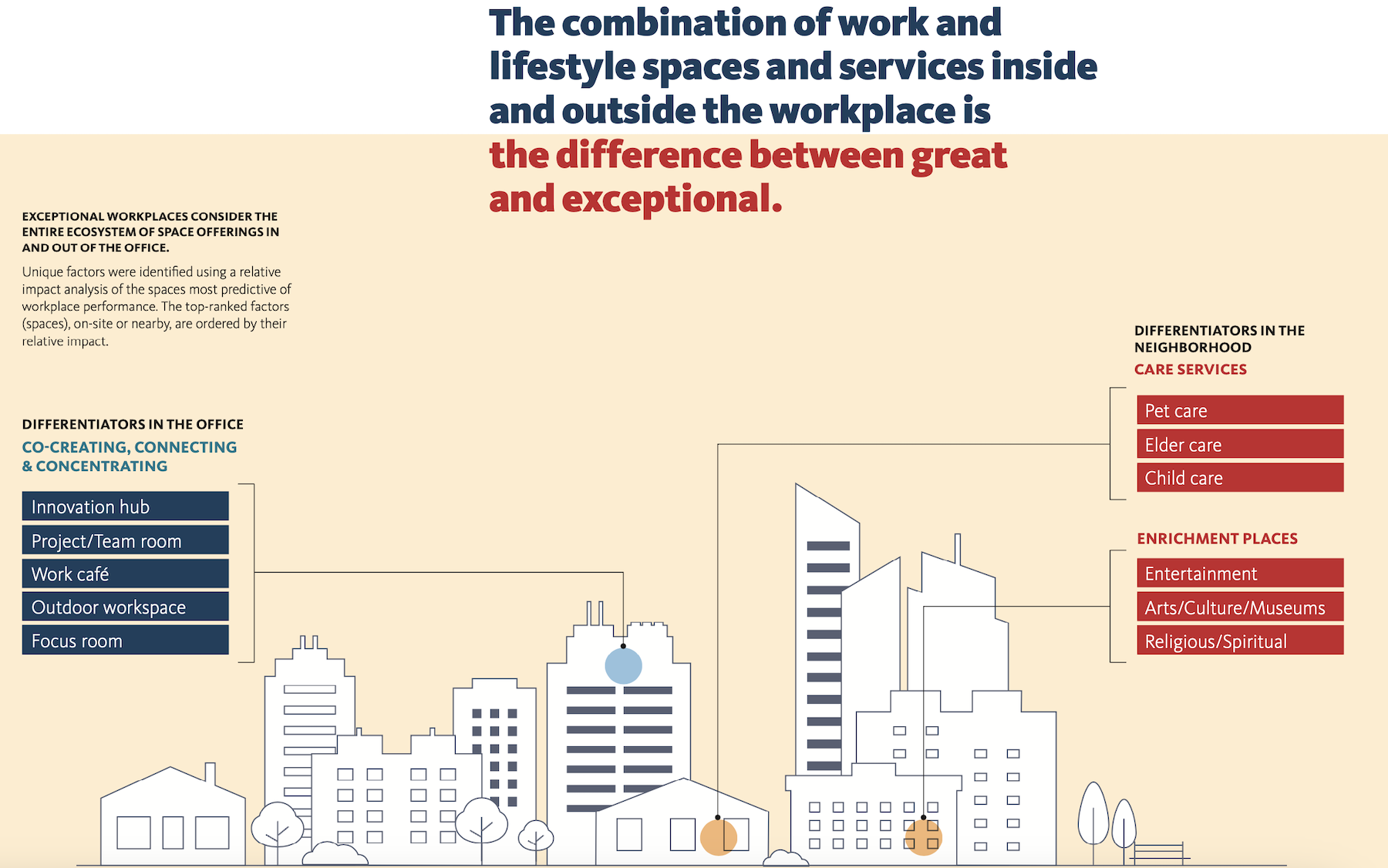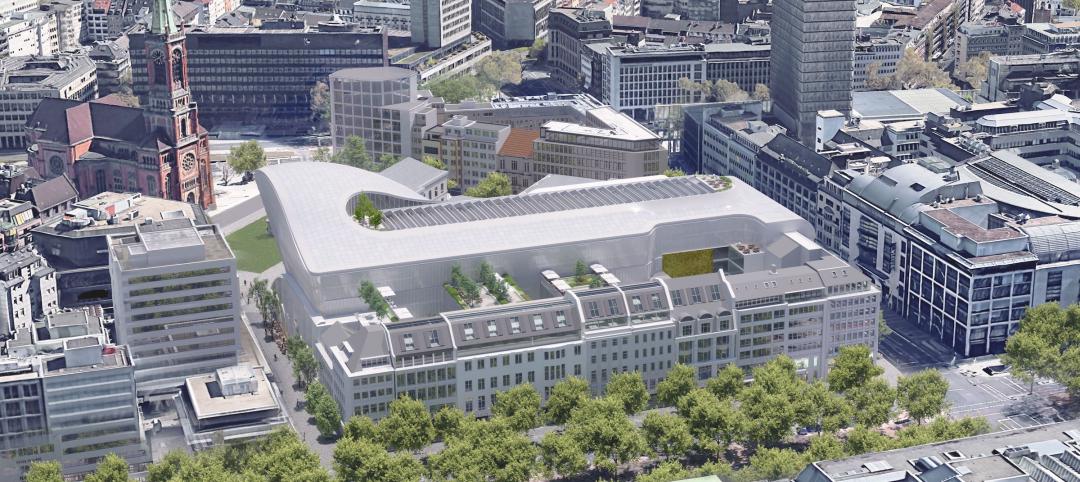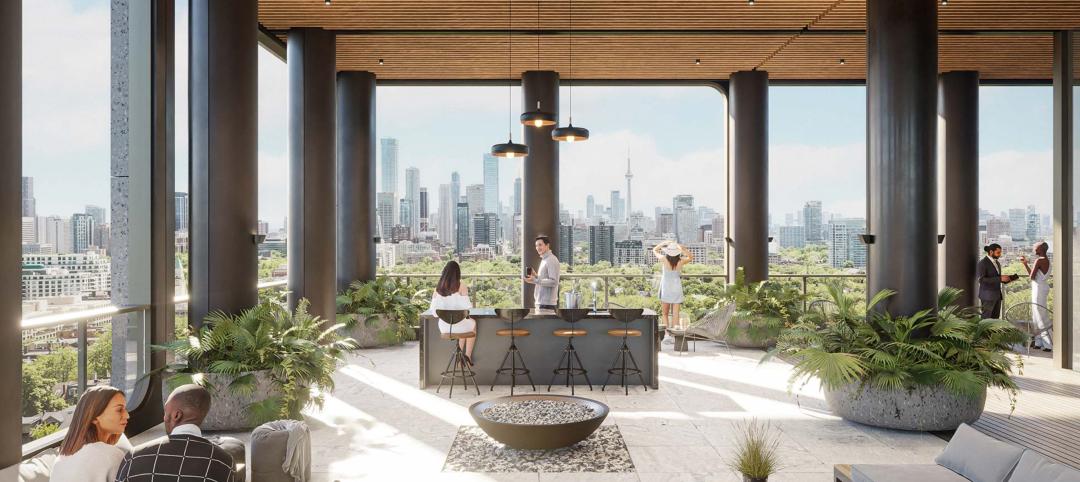For years, AEC firms and their developer clients have worked under the assumption that a good workplace is effective when it fosters working alone, with others in-person and virtually, learning, and socializing.
These factors are foundational as workplace performance indicators. “But having a good workplace is no longer enough,” states The Gensler Research Institute in its Global Workplace Report 2024, which is based on over 16,000 employee responses to a survey conducted in 15 countries and with 10 client industries. (The survey, conducted from October 2023 to January 2024, did not include fulltime remote workers.)
The report contends that employees are seeking different experiences that go beyond functional and effective office spaces, and now include feeling that the space is beautiful, welcoming, and inspires thinking. Within the office, spaces with the greatest impact on performance are innovation hubs, cafés, outdoor areas, and “focus” rooms. Beyond the building itself, exceptional workplaces leverage their surrounding neighborhoods’ amenities and services.
Gensler’s research shows, however, that many workplaces across industries and countries lag in the quality of their workplace experiences.
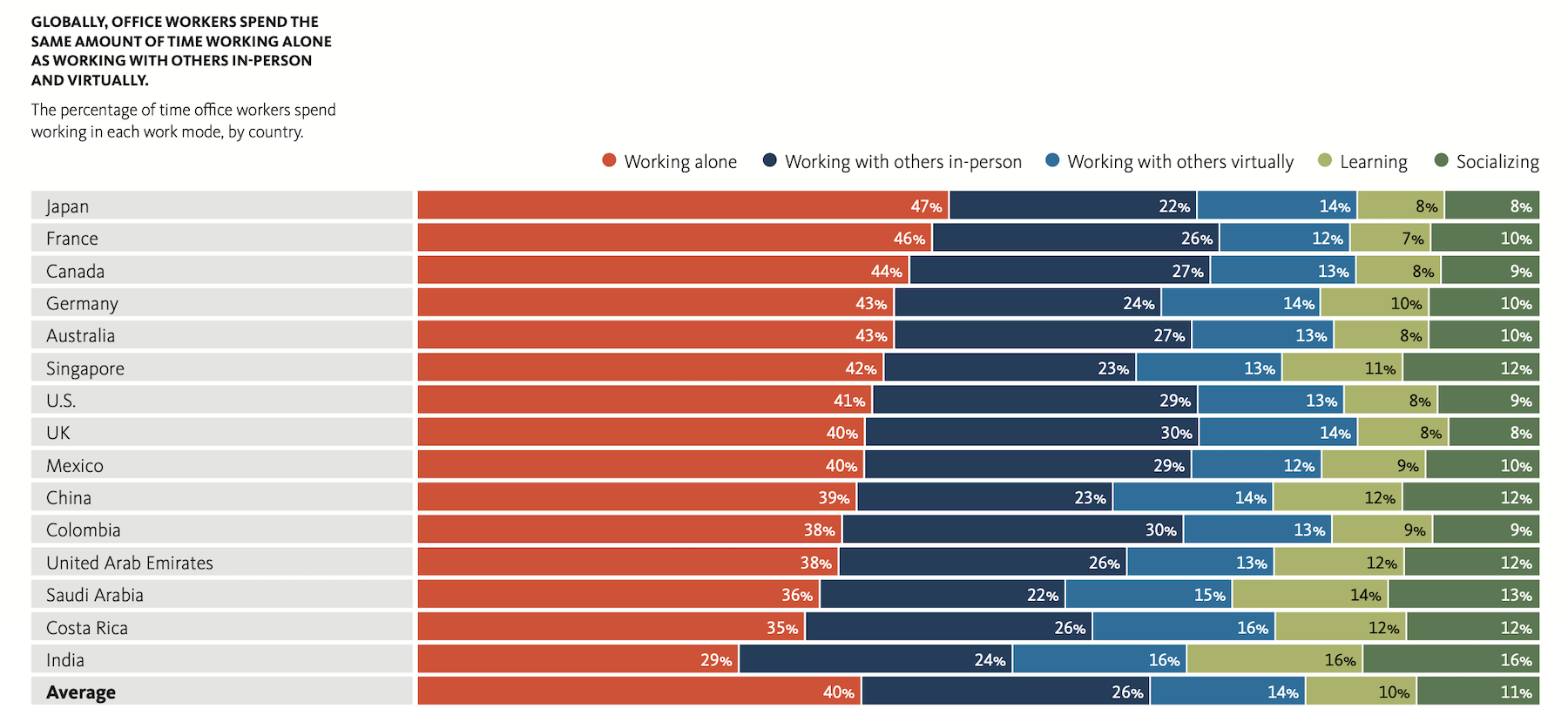
High-performing employees have more workplace choices
Gensler’s latest study highlights the shift, in gauging an office’s effectiveness, from real estate occupancy to people-centric performance measures, to assess the design impact on how employees work and feel in the workplace, individually, in teams, and as part of a company.
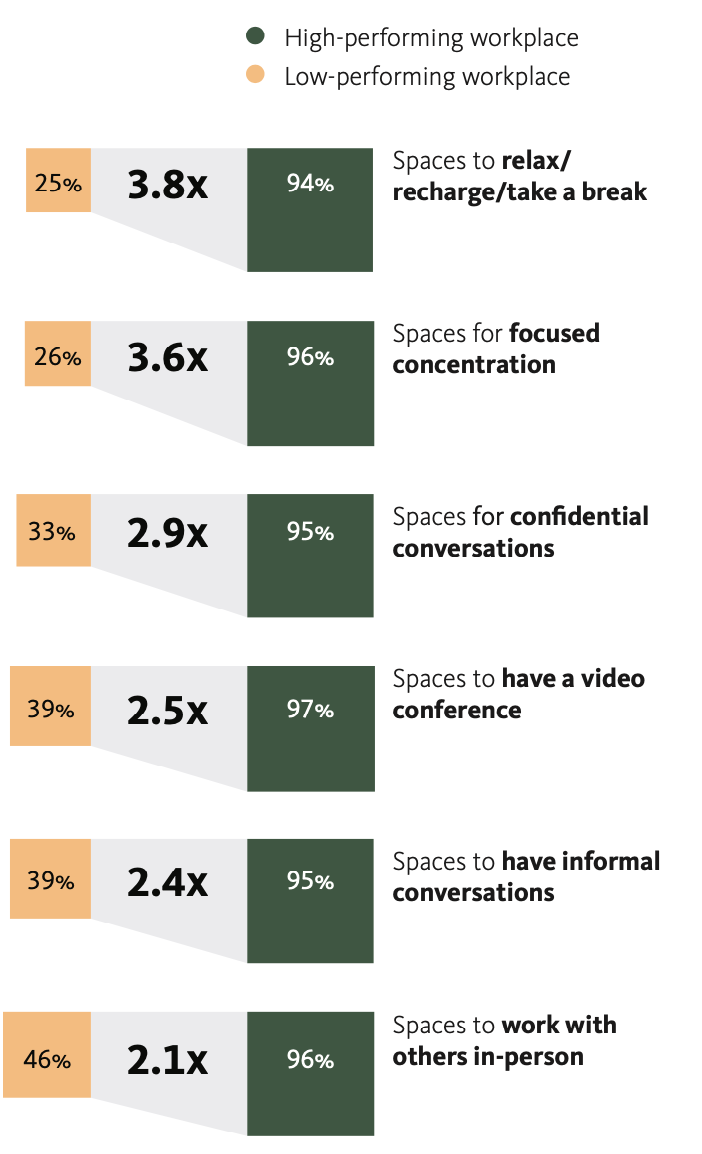
The report defines workplace performance as an average of two composite scores that measure how space supports work and how employees feel about that space. Effectiveness measures factors such as function, layout, and so forth; experience measures factors such as beauty and inspirational feelings.
Global office workers spend half of their typical workweeks in the workplace, 20% of their time at home, and 29% in other locations that might include coworking space. Pre-pandemic, this average was closer to 70% of time in the office. “Now, more than ever, the workplace needs to respond to a wider offering of spaces and experiences,” states the report, adding that employees across the world have unique and individual needs within the office.
The report looks closer at how top performing employees are experiencing their workplaces. The report scores the most-engaged individuals on factors such as how energized and happy they feel while working. Employees with the highest engagement score differ from other workers in the amount of time they spend working alone, learning, and socializing. (The report finds that these employees spend just 36% of their time working alone, versus 44% among the least-engaged employees.)
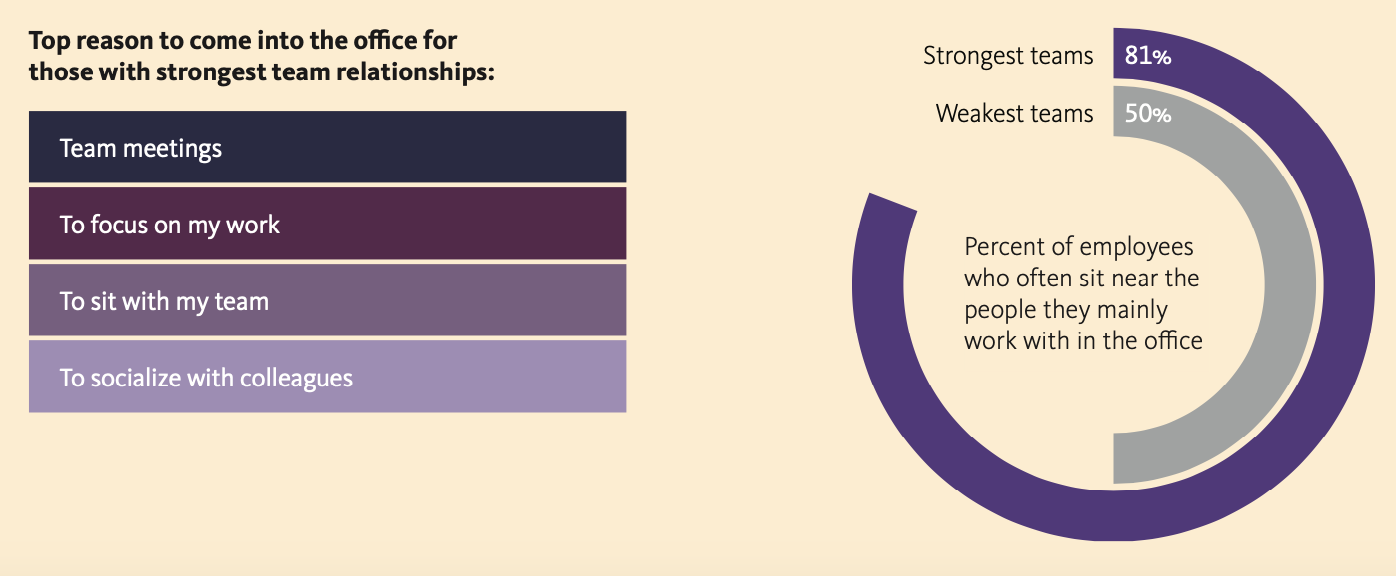
Nearly all top performers—96%––also say they have control over how they manage their time, versus half of those working in low-performing offices. Gensler emphasizes that “exceptional” workplaces offer their employees choices about where they work within the office. High-performing workplaces offer greater access to spaces for critical work activities, and overall have more work settings to choose from. This empowers the employees to work at the most effective spaces for their tasks.
It's not all about work, either. More than 90% of employees in high-performing workplaces says the office allows them to occasionally unplug from technology. And these workers also tend to use the office more for socializing and having fun.
Amenities add to workplace’s cache
Two-thirds of the workers surveyed describe their company’s office building as “one of the premium, higher-quality” commercial buildings in their areas. Gensler contends that building quality has a direct relationship to workplace quality: high-performing workplaces are twice as likely to be inside high-quality office buildings. These buildings, as often as not, are located in neighborhoods that offer diverse amenities, services, and alternate workspaces. High-performing workplaces, estimates Gensler, have access to 2.6-times as many amenity spaces on-site and 1.6-times as many amenities and services in the neighborhood. “Access to amenities and services appears to make a particular difference,” Gensler states about such “ecosystems” of spaces and experiences.

However, the report also finds that less than one-third of workplaces globally has been redesigned in the last three year, making these workplaces less likely to be able to meet the expectations of young people entering the workforce. “There’s a pressing need for organizations to intentionally rethink office spaces to boost company culture and drive business growth,” says Gensler.
Janet Pogue McLaurin, Gensler’s Global Director of Workplace Research, observes that a great workplace “must not only be a tool to get work done effectively but be intentionally designed for human emotion,” creating experiences that support new ways to work in and outside of the office.
Related Stories
Architects | Mar 8, 2023
Is Zoom zapping your zip? Here are two strategies to help creative teams do their best work
Collaborating virtually requires a person to filter out the periphery of their field of vision and focus on the glow of the screen. Zoom fatigue is a well-documented result of our over-reliance on one method of communication to work. We need time for focus work but working in isolation limits creative outcomes and innovations that come from in-person collaboration, write GBBN's Eric Puryear, AIA, and Mandy Woltjer.
Green Renovation | Mar 5, 2023
Dept. of Energy offers $22 million for energy efficiency and building electrification upgrades
The Buildings Upgrade Prize (Buildings UP) sponsored by the U.S. Department of Energy is offering more than $22 million in cash prizes and technical assistance to teams across America. Prize recipients will be selected based on their ideas to accelerate widespread, equitable energy efficiency and building electrification upgrades.
Sustainability | Mar 2, 2023
The next steps for a sustainable, decarbonized future
For building owners and developers, the push to net zero energy and carbon neutrality is no longer an academic discussion.
Industry Research | Mar 2, 2023
Watch: Findings from Gensler's latest workplace survey of 2,000 office workers
Gensler's Janet Pogue McLaurin discusses the findings in the firm's 2022 Workplace Survey, based on responses from more than 2,000 workers in 10 industry sectors.
Seismic Design | Feb 27, 2023
Turkey earthquakes provide lessons for California
Two recent deadly earthquakes in Turkey and Syria offer lessons regarding construction practices and codes for California. Lax building standards were blamed for much of the devastation, including well over 35,000 dead and countless building collapses.
Sports and Recreational Facilities | Feb 27, 2023
New 20,000-seat soccer stadium will anchor neighborhood development in Indianapolis
A new 20,000-seat soccer stadium for United Soccer League’s Indy Eleven will be the centerpiece of a major neighborhood development in Indianapolis. The development will transform the southwest quadrant of downtown Indianapolis by adding more than 600 apartments, 205,000 sf of office space, 197,000 sf for retail space and restaurants, parking garages, a hotel, and public plazas with green space.
Retail Centers | Feb 24, 2023
Santiago Calatrava unveils plans for a luxury retail and office complex in Düsseldorf, Germany
Renowned architect and engineer Santiago Calatrava, along with the CENTRUM Group, has unveiled plans for Calatrava Boulevard, a luxury retail and office complex in Düsseldorf, Germany. Running parallel to Königsallee and connecting with the Steinstrasse station, Calatrava Boulevard will incorporate and connect to the boulevard’s existing buildings.
Reconstruction & Renovation | Feb 16, 2023
Insights from over 300 potential office-to-residential conversions
Research from Gensler finds that, surprisingly, the features that result in an unpleasant office often make for a superlative multifamily product.
High-rise Construction | Feb 15, 2023
Bjarke Ingels' 'leaning towers' concept wins Qianhai Prisma Towers design competition
A pair of sloped high-rises—a 300-meter residential tower and a 250-meter office tower—highlight the Qianhai Prisma Towers development in Qianhai, Shenzhen, China. BIG recently won the design competition for the project.
Office Buildings | Feb 12, 2023
Smyrna Ready Mix’s new office HQ mimics the patterns in the company’s onsite stone quarry
Designed by EOA Architects to showcase various concrete processes and applications, Smyrna Ready Mix's new office headquarters features vertical layering that mimics the patterns in the company’s stone quarry, located on the opposite end of the campus site. The building’s glass and concrete bands are meant to mirror the quarry’s natural contours and striations.


